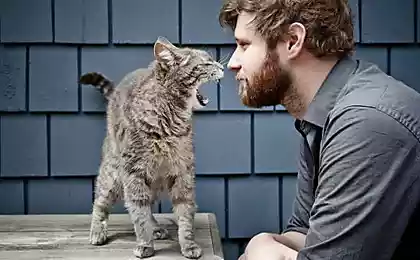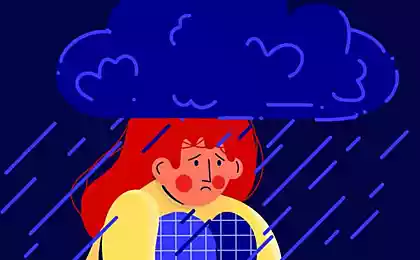203
Anthology of aggression

“Aggression serves social relations; it protects them. It manifests itself whenever ties are threatened, when they do not develop positively or are absent. People who see a threat to relationships that are important to them, who are deprived of trust or excluded from society, react to these circumstances with aggression.
One of the latest studies in this area belongs to Ragnar Beer from the Institute of Psychology in Göttingen. In the course of extensive research, he was able to prove that most people who face a serious threat to their relationship with a partner react to it with aggression. 72% of women and 49% of men spoke of anger in these situations, 67% of women and 56% of men spoke of irritability, 22% of women and 13% of men spoke of hatred.
The relationship between relationship development and aggression can be demonstrated by neurobiological methods. An example is the observations of the American scientist Paul Zack, who showed that distrust of a person increases the level of an important “hormone of aggression” in the blood – dihydrotestosterone (DHT). Zach ran an experiment in which two subjects could make a deal.
The participant of experiment A receives a sum of money from the head. He can invest any part of this amount by giving it to participant B, whose invested amount will increase, because [in this case] the experiment manager increases the amount transferred to participant B by 3 times. As in life, so in this experiment, the investment on the part of participant A (i.e., the transfer of part of the money to participant B) is a matter of trust, because B, who now has three times the amount, is free to decide what percentage of it he returns to participant A.
Since the course of the experiment was first communicated to both partners, the amount A would transfer to the partner at the beginning of the experiment depended solely on trust. The researchers were interested in how participant B would respond to A’s expressed (or not manifested) distrust. The result was that a large investment by A caused B to increase levels of the “trust hormone” oxytocin. Limited trust or distrust caused another subject to increase their DHT levels.
Experiments like this show that trust breeds trust. Distrust and rejection favor aggression because they cause pain.
An Anglo-Saxon proverb says, “If you can’t beat them, join them.” The results of the latest psychological and neurobiological research force her to turn from head to foot: “If you can’t join them, beat them.” This new formulation belongs to the Californian researcher of aggression Jean Twenge. Only in those cases when it is not possible to find understanding from other people, join the community or when the threat of the collapse of personal relationships comes the need to react to the circumstances with aggression and struggle (if you are not ready to give up and give up - otherwise the reaction to them is limited to sadness and depression). Research shows that violent acts (both by children and adolescents and adults) occur mainly when people are in danger of breaking important relationships, when society is unwilling to accept them, humiliates or repels them.”
The immediate cause of aggression in a person is pain, and we are arranged in such a way that consciousness does not make a distinction between physical pain and mental pain from rupture / violation of close relationships from humiliation, etc. At the brain level, both manifest and act in exactly the same way.
Research by Naomi Eisenberger shows that unexpected social isolation not only has psychological consequences, but also affects human neuroscience.
“Adult subjects were in a CT camera and could play ball with a joystick on a computer monitor, giving passes to each other. The subject had to pass the ball on a monitor to only two other players. He was told that the two were also subjects, and the purpose of the experiment was to study brain reactions in a game situation. He did not receive any other information. For a time, the game went so that both players in the next room passed the test subject the ball as often as they did each other. But suddenly -- this was part of the experiment -- the behavior of the invisible participants in the game changed. They began, for reasons unknown to the subject, to pass the ball only to each other and thus excluded the subject from the game. The brain image taken in this situation recorded the activation of pain centers, which is usually observed when causing "real" physical pain [pain is recorded in several centers of the brain; this is the thalamus, islet, sensory cortex and, most importantly, the cingulate gyrus cinguli. The same centers are activated when the pain in front of your eyes is caused not to you, but to a close (and “socially close”) person. V.K.
This experiment proves that purely social isolation has unambiguous biological consequences.”
The reaction of confusion in response to social exclusion (the interruption of the mirror-reflective feedback of body movements and facial expressions that provide communication, and not only non-verbal, but also speech) along with its “internal trace” in the form of stress reactions manifests itself already in newborns. Perhaps nothing leads an infant to a stronger reaction of rejection and rejection than the so-called “still face procedure.” “The face of a loved one is at the right distance from the child’s face. If now an adult, contrary to his own emotional intuition, intentionally keeps a still facial expression, the child will impulsively turn away from it. If this procedure is repeated several times, it will cause an emotional decline in the child; his willingness to repeat attempts to exchange facial signals decreases.
Although the newborn does not yet know how to distinguish himself as a separate person in the first weeks of life, the early mirror exchange of glances and facial signs creates in him the first intuitive sense of social connection (which will then accompany him for life). After all, people (like crows, like other social creatures) can understand the world not from scratch, not absolutely, but only as a deviation from the “already accepted”. As modern research on so-called mirror neurons (1-2-3) shows, this “already accepted” = the “oven” from which the individual dances in his own cognition and action, not his individual “I”, but an intersubjective connection with other people. This “already accepted” is put into us by society, including with the help of mirror neurons – why their discovery is so remarkable. V.K.
Since at this time the newborn does not yet know how to distinguish himself from others, the scientists called this communicative exchange at an early stage of life “intersubjectivity without subject”, that is, interpersonal relationships, in which, however, it is not yet possible to speak of the child as an active subject. However, the child develops a fundamental sense of intuitive connection with other beings of the same species, coexistence with them in a shared emotional world. This feeling, resulting from the processes of mutual mirror reflection, which Vittorio Gallese called S-Identity, corresponds to a primordial human need.
Thomas Inzel, who currently directs the National Institute of Mental Health (NIMH) in the US, wrote a review article on the topic with the ironic title Is social attachment an addictive disorders? (Is social attachment really drug addiction?) Scientists have found that at the age of two months young children actively seek emotional harmony with their mother. Very inventive and subtle experiments have shown that in the third month of life, the child develops a sense that through the manifestation of various signs of life, he can cause a change in the behavior of reference persons. During this period, the infant also begins to direct his attention towards the direction of the adult’s gaze (that is, attention). This is the first sign of the so-called joint attention, that is, reflective settings for the purpose of joint attention.
... mirror neurons are the neural format of a supra-individual, intuitively given shared space of understanding. This space forms a corridor in the bandwidth of which are neural programs of all that members of the social community consider possible or conceivable experience or behavior. On the one hand, every individual has a mirror neuron system. But at the same time it forms a common multiple (the shared manifold, the term Vittorio Gallese), a kind of fund in which the programs of all actions and experiences that are fundamentally possible or conceivable within a given social structure are collected. Mirror neurons represent a common social space of resonance, since the sensations or actions of one individual lead other individuals directly observing the data to such reflective activity of their neuronal systems as if they themselves feel or do the same, although in reality they are only observers. From this, and only from this, arises an immediate, unconscious feeling of a kind of soul kinship: “I am basically the same as everyone else, and others are essentially the same as me.” We begin to understand the meaning of this feeling only when we lose it.
Having this feeling is not taken for granted. What we have (maybe) we owe to mirror neurons.
[absent in the lower vertebrates, and because we have them mediating the whole spectrum of actions, experiences and feelings, not just a narrow sector of behavior patterns, like parrots and songbirds, where mirror neurons work only to learn to sing.]
I think that the idea of social equality grows out of this sense of gentile community, just as the sense of justice is a protest against the violation of this original, natural equality. In fact, every idea begins with an understanding of feeling; the basis of the idea of equality is the biological fact of the presence of this most common multiple of a given community, and now of all mankind, and those feelings of justice / injustice that are caused by the confirmation or denial of this fact in human interactions. Or watching how the media interact with each other, which is a great source of manipulation. But one way or another, this most general multiple is that which is accepted without evidence, the very “oven” from which the individual dances in the process of cognition and understanding of the world, as seen above. V.K.
Violation of this organic connection of the individual with other people (represented in the structures of social relations) due to various forms of oppression or social exclusion of the individual causes pain, stress and, accordingly, aggression.
“Neurobiological studies have provided an interesting answer to the question of the relationship between social rejection and aggression. It is intuitive to understand that pain causes aggression, but why does aggression cause a relationship to be threatened and lost? It turns out that socially “constructed” beings, such as humans, react to exclusion as much as they do to physical pain. The brain makes little distinction between social pain and physical pain (see Jaak Panksepp). Social isolation is experienced by the body as pain not only from a mental but also from a neurobiological point of view, and it responds to it with a measurable response to biological stress.
As already described, the working group led by Naomi Eirenberger proved using the method of NMR imaging that social isolation activates important parts of the neurobiological centers of pain in the brain. Laura Stroud and others have found that social rejection not only mobilizes the brain’s emotional centers, but also causes elevated blood pressure and levels of the “stress hormone” cortisol. The functional relationship between (lost) relationships and aggression is indicated by the results of experiments on animals in which the oxytocin mediator, important for social relations, was “disabled” using genetic engineering methods. The behavior of these animals was very aggressive; so much so that mothers, after switching off oxytocin synthesis, could kill their young.
Further, if social isolation can cause pain, can cause stress, knocking the naive individual out of the saddle, then the deliberate infliction of isolation, "behavioral exclusion from the collective" [under capitalism] can become an effective tool of competition. And yes, it turns out, in office slavery, you can't do without a whip.
We are talking about the so-called mobbing [although the term is unsuccessful, because it is preoccupied]. In ornithology and other zoology, mobbing is the shouting of a predator by peaceful birds or mammals, its potential victims. Seeing that it is detected and its movements are clearly tracked, most predators are stressed and refuse to attack. Often, the very cries of alarm of potential victims cause the predator the same stress through which they make other individuals of their own species nearby worry, to make them worry and, accordingly, also scream (but this is in the case that the corresponding screams or movements are used in communication as stimuli). If the same or homologous cries/body movements in another/close species are used as signals-symbols, then they do not affect the motivational state of recipients of their own species, but simply convey information about the danger in a symbolic form; accordingly, they do not stress the predators specifically, but only “discourage” them by the facts of detection. V.K.
The experience of exclusion from the social community, of falling out of the space of social resonance, has proven neurobiological consequences. In cases where people are deliberately and for a long time excluded from the community, such consequences can be diseases, in extreme cases - death. Exclusion from the community means the systematic deprivation of reflective patterns of behavior in everyday life by which we involuntarily demonstrate to each other that we regard the other person as belonging to a common social space. These models apply to all variants of mirror reflection: the person is deprived of intuitive signals of body language, such as short resonance reactions in fleeting encounters or various opportunities for mutual understanding through glances. In the absence of such signals, a person feels surrounded by a wall of ice. In addition, in the case of exclusion actions, joint attention falls, that is, consideration of what the excluded person is focused on or what he wants to draw the attention of others. A person is deprived – and this is already a large-caliber weapon – of mutual reactions in conversation, ignoring his statements or questions as if they did not exist.”
“Systematic deprivation of social resonance at work, so-called mobbing, is now considered an important factor in the development of diseases. And this is not surprising, because the “purpose” of mobbing is precisely to exhaust, torture and destroy the person. Recent research shows that psychopathic individuals are a high percentage of the ruling elite, suggesting that the problems associated with mobbing are likely to increase. Among others, these results were obtained in the framework of the study of “corporate psychopathy” conducted by the American expert in the field of economic psychology Paul Babiak (Paul Babiak).
Mobbing is so often used as a means of competition among all sorts of managers that I would even suggest selective accumulation “at the top” of the management hierarchy of large firms of these very individuals with psychopathic tendencies – since they will be the most successful in mobbing. In any case, in Germany and other countries, this is already becoming a public problem that worries psychiatrists and the controlled themselves, so you see, such a study will be conducted.
And most interestingly, as well as parental behavior, aggression is reproduced through training, when increased aggression is primarily associated with the experience of the experience of violence.
“Dario Maestripieri’s research in primates shows that early experience influences the development of behavior more strongly than the existing biological-genetic constitution of the animal, and the effect of this influence is transmitted to the next generation.” Maestripieri showed the decisive influence of a person’s experience of violence on the development of aggressive behavior. Preparation for violence arises mainly from the fact that individuals have experienced violence against themselves. The scientist studied the behavior of female monkeys in the primatological center. The behavior of most females was characterized by the protection and care of the offspring after each pregnancy. But some females, from the moment of birth, treat them rudely, oppressively and cruelly, and this behavior persists after each birth.
Maestripieri singled out 2 groups of pregnant females, while half of the caring mothers he left after childbirth their own children, and the other half of the (caring) mothers immediately after childbirth took their children and gave - as foster children - cubs born cruel females. The same was done with females who turned out to be cruel mothers: half of them left their own children, and half received foster children born to caring females. When the monkeys' childhood ended, they were separated from their mothers and kept in general conditions the same for all.
When they reached sexual maturity, and the females of this generation brought offspring, the subject of observation was their attitude to their own young.
The result: all female mothers who spent their infancy with caring mothers treated their young with care and attention. Thus, this behavior of the animals was completely independent of their origin, that is, it was not affected by what genes they carried, caring or cruel mothers. Conversely, those animals that grew up with abusive mothers in most cases (50-60%) behaved cruelly towards their offspring, even when it was about individuals born to caring females and therefore had their genes. When it comes to behavior, life experiences, especially learning experiences, are obviously more powerful than genetic origins.
A number of recent studies, including the working group of the American ethologist Craig Anderson, indicate that where aggression is the main pattern of behavior, learning processes play a decisive role along with the experience of violence. And, in particular, watching videos with scenes of violence and so-called killer computer games.” published
Sources from which quotes in quotation marks
Joachim Bauer. Why do I feel what you feel? Intuitive communication and the secret of mirror neurons. St. Petersburg: Wergner Regen, 2009. 112 p.
Joachim Bauer. The principle of humanity. Why are we inherently cooperative? SPb.: Werner Regen, 2009. 152 p. This book is tainted by repeated attacks on the “Darwinian Principle of the Struggle for Existence,” clearly from a Christian perspective; Dawkins’ parallel exposé of sociobiology is well-founded.
Source: wolf-kitses.livejournal.com/249379.html























